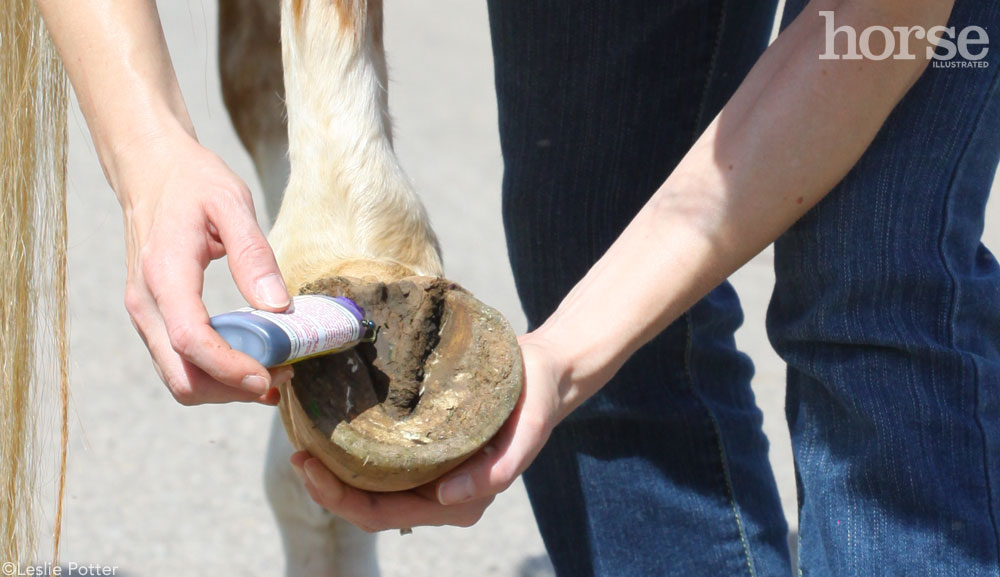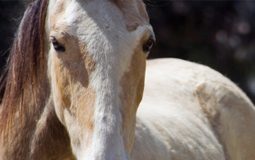
A: Thrush is a very common hoof ailment in horses, but it is rarely serious
and relatively simple to treat. A mere bacterial infection around the frog of a horse’s hoof, this condition causes a distinct black, smelly build up of necrotic exudate (dead cells and general gunk) in the sulci, or deep grooves, in the center of and around the frog. The bacteria that cause this condition, usually Fusobacterium necrophorum which is the same bacteria that causes foot rot in cattle and sheep, grow and thrive in the hidden, constantly moist crevices of hooves standing in muddy and wet areas, stalls soaked in urine, or those that are not frequently cleaned out with a hoof pick.
Horses with deep sulci in their frogs are also predisposed to this condition, as these deep clefts provide perfect caves for these bacteria to hide and proliferate. Conformationally, horses with long contracted heels are also at greater risk for developing thrush. Age is not a factor for developing thrush.
The treatment for thrush centers on drying out the sole of the hoof since little moisture yields little bacterial growth. Note I didn’t say no moisture. A frog that is too dry will flake and lose some of its flexibility and shock-absorbing qualities. There should be a two-pronged attack on thrush. The first part is to take control of the hoof environment. Clean your horse’s hooves twice a day and try your best to have the horse stand in dry areas with good drainage. Sometimes this is difficult, as in the spring with heavy rains or in the winter with snow. Also, sometimes, horses will choose to stand in the muddiest part of the field no matter what you do! If the horse is stalled, make sure to clean the stall daily and provide plenty of fresh, clean bedding. Some horses with thrush also benefit from a visit with the farrier. The farrier can trim excess frog away, allowing air and medication to more easily penetrate deep into the sulci.
The second part to thrush treatment is topical medication. A majority of thrush treatments are over-the-counter drying agents that are applied directly to a freshly cleaned hoof once to twice daily. These treatments often contain an astringent such as iodine or copper sulfate. Anecdotally, some people have been known to use household bleach to treat thrush. This is not recommended, as bleach can over-dry the tissues and cause more harm than good.
Also note that although thrush is a bacterial infection, antibiotics are not prescribed as treatment as long as the infection stays on the surface of the hoof. Occasionally, a severe or chronic case of thrush can penetrate beyond the superficial epithelial tissue of the sole and migrate into the soft tissue and sensitive laminae of the hoof. This will cause lameness and will constitute a visit from your veterinarian, as a more vigorous treatment protocol will need to be followed. Very rarely does the infection become severe enough to migrate further and involve deeper structures within the hoof, such as the joint capsule of the coffin bone. This is a very serious situation. These examples are why it’s best to catch and treat thrush early.
Of course, the best treatment is prevention, so instituting a habit of regular (i.e. once daily at least) hoof cleaning helps to remove manure and mud from deep within the sulci of the hoof as well as give you a chance to monitor hoof health. Providing clean, dry bedding is also of paramount importance if your horse is stalled.
Ensuring proper drainage of paddocks and dry lots also helps ward off thrush as well as other dermatological conditions such as scratches.
Further Reading
Two Minutes with Tab: Thrush
Thrush in Horse Hooves
Horse Health Glossary: Thrush






Thrush can also be brought in on the farrier’s tools. One of the driest summer, I had a colt get trush…and so did alot of the this farrier’s other clinents, only to find out that one horse kept in a wet stall on the farrier’s barn, started it all.
I use peroxide in a spray bottle to get rid of my horses’ thrush in the spring and winter, but unless you live in an all year wet weather area, you shouln’t need to even worry about thrush in the summer!
Good advice.